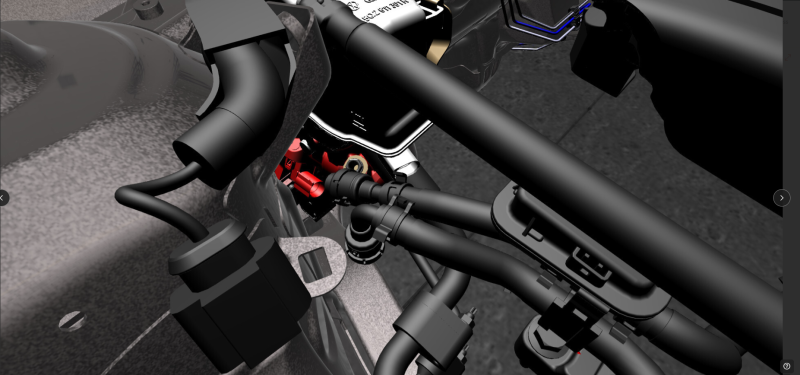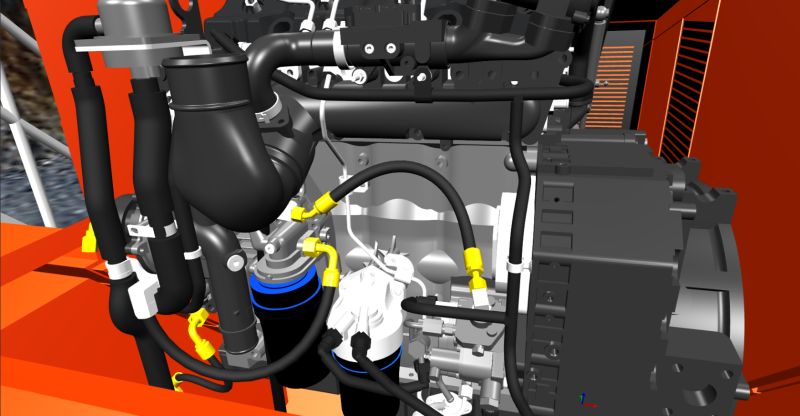How Virtual Reality Accelerates Automotive Design and Manufacturing
Simulating Elastic Parts in Augmented Reality Holds Multiple Benefits for Automotive Engineering

The automotive industry is under pressure to innovate at an extraordinary pace to meet emerging environmental, technological, and societal demands. This requires exceptionally efficient and accurate product development. Traditional automotive product development cycles often rely on extensive physical prototypes and real-world testing. These design cycles are lengthy, expensive, and resource-intensive, and when design changes are required, alterations and re-testing are cumbersome and inefficient.
Virtual Reality (VR) technology is the necessary tool to address these challenges for the next generation of automotive design. Manufacturers can create virtual replicas of real-world conditions through advanced simulation and modeling techniques, allowing them to design vehicles and systems that meet the highest standards for safety, manufacturing efficiency, and regulatory compliance.
In this article, we look at ESI's VR software, IC.IDO, and highlight some examples of how virtual reality simulation is used.
Industry Challenges in Traditional Simulation Approaches
Traditional simulations in automotive manufacturing engineering often fail to capture real-world assembly complexities, leading to costly errors and delays. Automotive engineers and manufacturers heavily rely on elastic parts, like clips, hoses, and wiring harnesses, during the assembly process. These parts twist, bend, and undergo manipulation during assembly. This necessary deforming of the plastic parts can have consequences such as breakages or weakening.
Traditional simulations struggle to predict the behavior of these parts during this time. Offline Finite Element Method (FEM) simulations, which are a common tool in automotive product development, depend heavily on experts who often work in isolation. This approach can overlook workers' real-world conditions while assembling or disassembling components and lead to designs that just aren’t feasible on the factory floor. Further, these failings are only discovered very late in the manufacturing process resulting in a part that cannot be assembled.

Traditional simulation can neglect the complexity of assembling wiring, clips, and hoses. (C) ESI Group 2024
The advantages of running complex, multifaceted simulations are clear and significant. These simulations enable the identification of potential issues early in the development process, allowing for efficient troubleshooting within a trial assembly environment. By evaluating how the part behaves, they not only validate the assembly process but also ensure that the technician’s role is considered, promoting a safe and optimized work environment.
Use of IC.IDO for Elastic Part Simulation | Key Features and Advantages of IC.IDO VR Engineering Software
IC.IDO is an immersive virtual reality technology designed to enhance collaboration and improve decision-making across various stages of product development. It allows users to experience full-scale digital prototypes in real-time, enabling teams to interact with virtual models in the manufacturing and assembly process, assess design feasibility, and optimize assembly processes before physical production.
IC.IDO’s VR technology simulates elastic components, offering development managers and engineers the ability to optimize workflows and cut validation costs. It estimates the force required to install elastic parts, helping prevent potential damage or dangerous situations during assembly.
The capabilities of this VR technology go beyond a streamlined digital validation process. With IC.IDO, you can create an immersive experience and a virtual reality in which you simulate interactions between rigid and flexible components using kinematic chains analysis and multi-body physics. It also offers advanced tools like the SpaceMouse and VR headsets to enhance your interaction experience.
Dive into the World of Zero Tests, Zero Prototypes and Zero Downtime with ESI
Discover the full potential of next-generation VR simulations for engineering and manufacturing validations
Furthermore, the ESI LIVE Automotive event, which took place in October 2024, was a brilliant opportunity for anyone interested in gaining more knowledge on the use of advanced virtual reality for simulation and design in manufacturing. Register today to watch on-demanc!

IC.IDO’s VR technology simulates stress points of elastic components, providing development managers and engineers with accurate insights into installation challenges. (C) ESI Group 2024
Additionally, you get optimized data preparation and visualization features such as bending radius analysis and von Mises stress evaluation. Together, these features provide a more robust design for complex applications, including automotive assembly line processes and factory floor planning.
Maximizing Efficiency and Return on Investment: What are the Use Benefits of VR in the Manufacturing Industry?
The growing adoption of advanced VR solutions like the IC.IDO elastic part simulation are transforming how flexible components are modeled and analyzed during assembly, streamlining the validation process. By reducing the need for costly prototypes and minimizing late-stage errors, this approach provides more accurate insights into part behavior, enhancing both precision and efficiency in manufacturing industries .
By reducing the need for manufacturing physical prototypes, advanced virtual reality simulations help minimize costs. Validating designs in a virtual environment eliminates the trial-and-error phase with physical models, speeding up development and reducing design revisions. This leads to a higher return on investment (ROI) while enabling teams to collaborate more effectively across the board.
How Can VR be Used in Automotive Engineering and Manufacturing?
Simulations enabled by IC.IDO are transforming manufacturing engineering beyond the automotive industry by reducing costs and accelerating time-to-market. With advanced elastic simulations and real-time validation, users can achieve greater design accuracy while streamlining development processes. These innovations enhance collaboration, drive efficiencies, and improve overall product quality, thanks to advancements in digital validation.
Consider the process of assembling a wheelhouse cover. This part needs to be bent in a specific way for installation and also involves multiple clip points. In the IC.IDO simulation, you can test the wheelhouse cover installation in precise detail, such as determining which clip should be engaged first. Within the simulation, you can snap in one clip of the wheelhouse cover and proceed with the others, gaining insight into how the part behaves under stress. You can analyze surface stress to assess whether the part is being overbent—such as bending the right-hand side too much, potentially causing a defect later. This allows for easy validation to ensure that excessive force is not applied during assembly.

IC.IDO's VR technology is an efficient way for visualizing how workers will interact with components during installation. (C) ESI Group 2024
Designed with a human-centric approach, IC.IDO allows users to visualize how technicians will interact with components during installation. Its shape validation capabilities further enable an assessment of a part's final form after assembly, ensuring a smoother and more accurate development process. Returning to the example of a vehicle assembly, IC.IDO would enable engineers to test every aspect of the installation to see how parts are manipulated during the assembly process.
What are the Benefits or AR and VR in the Automotive Industry? Let's look at an Example Case Study on How Mercedes Benz is Using Virtual Reality
A prime example of how the method of dynamic buildability validation can enhance assembly processes is Mercedes-Benz, where VR simulations have been instrumental for two decades. The company has been employing technologies like VR to test new insulation concepts before any physical prototype is built. Digital vehicle validation is becoming increasingly important for Mercedes Benz and other leading automotive brands as fewer hardware prototypes are built. Dynamic buildability validation is already used in the concept phase.
Some years ago the washer fluid reserve was mounted in the front fender of Mercedes Benz vehicles, a location that needed to be verified for ease of installation. This was done in virtual reality (VR), where the team ensured that the washer fluid reserve could be efficiently installed by the workers on the production line. This digital validation step not only confirmed the physical feasibility of the design but also streamlined the assembly process.
The Future of Virtual Reality in Automotive Engineering and Manufacturing
Engineers at manufacturing companies will drive growth in digital validation VR solutions, especially in automotive applications, as their need for these tools increases. Next-generation VR simulation software like IC.IDO are critical in achieving optimal maturity levels in early development phases.
These advancements include innovative strategies for ensuring safety compliance by enhancing seating design and pre-certification as well as next-generation simulation and design techniques for improving Electric Vehicle (EV) sound performance. Furthermore, the use of advanced reality (AR) and extended reality (XR) technology in the industrial metaverse enables collaboration across design, manufacturing, and maintenance teams, creating immersive environments for virtual product integration.
What is a Transformative Application of VR Across Diverse Industries?
Automotive manufacturing has been a pioneer in using next-generation virtual reality simulations, and more companies have already shown interest in its benefits for the manufacturing process. However, the potential and reach of this technology is vast. In the aerospace industry, the ability to immersively visualize future products and components enables aerospace and defense companies to avoid costly and limited physical prototype testing without compromising accuracy, safety, or time-to-market.
Similarly, in heavy machinery industries like construction, agriculture, and mining, manufacturers can employ virtual reality for improved design integration, reduced lead times, and the ability to simulate human-machine interactions for optimized assembly and maintenance. This approach of predictive maintenance maximizes machinery uptime and operational efficiency, while lowering costs and enhancing sustainability throughout the product lifecycle.
Denise is a seasoned media and communication professional with over 15 years of experience in the IT industry, spanning logistics and asset management software to system simulation and virtual prototyping (CAE & PLM). With a deep passion for technological innovation and sustainability, Denise is a steadfast ambassador and fervent advocate for Virtual Prototyping, utilizing her extensive expertise to steer companies through the conundrum of terminology in the era of digital and AI. As the Sr. Marketing Content Specialist at ESI, Denise creates insightful publications that help businesses understand the technologies, methodologies, and value of shifting from physical to virtual prototype testing – a transition that is facilitated through the utilization of CAE software, augmented with immersive tools and hybrid AI technologies.